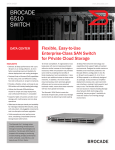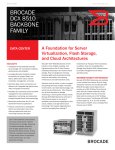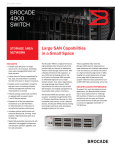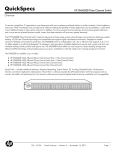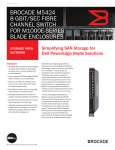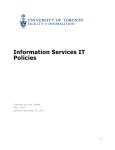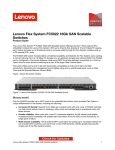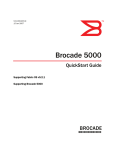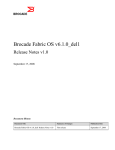Download DELL Brocade 300 SAN
Transcript
Data Sheet Brocade 300 Switch Storage Area Network Highlights •Provides an affordable, flexible foundation for entry-level SANs, and an edge switch for core-to-edge SAN environments •Delivers up to 24 ports of 8 Gbit/sec performance in an energy-efficient, optimized 1U form factor to support the most demanding server and virtual server deployments •Simplifies configuration and management with easy-to-use tools such as the Brocade EZSwitchSetup wizard, and is Microsoft Simple SAN-compatible •Enables “pay-as-you-grow” scalability from single-switch fabrics to full-fabric enterprise capabilities with Ports On Demand scalability from 8 to 16 or 24 ports in 8-port increments •Offers dual functionality as either a full-fabric SAN switch or as an NPIV-enabled Brocade Access Gateway that enhances fabric scalability and simplifies management •Protects existing device investments with auto-sensing 1, 2, 4, and 8 Gbit/sec capabilities and native operation with Brocade and Brocade M-Series fabrics •Future-proofs investments by enabling organizations to use 4 Gbit/sec SFPs today and upgrade to 8 Gbit/sec SFPs when required Third-party information provided to you courtesy of Dell Small SAN Affordability with Growth Capabilities As the value and volume of business data continue to rise, organizations need technology solutions that are easy to implement and manage, and that can grow and change with minimal disruption. The Brocade® 300 Switch provides small to medium-sized enterprises with SAN connectivity that simplifies their IT management infrastructures, improves system performance, maximizes the value of virtual server deployments, and reduces overall storage costs. The 8 Gbit/sec Fibre Channel Brocade 300 provides a simple, affordable, single-switch solution for both new and existing SANs. To simplify deployment, the Brocade 300 features the EZSwitchSetup wizard and other usability and configuration enhancements, as well as the optional Brocade Access Gateway mode of operation. Moreover, it provides state-of-the-art performance and Ports On Demand scalability to support SAN expansion and enable long-term investment protection. INCREASED EFFICIENCY TO MANAGE BUSINESS GROWTH The Brocade 300 significantly increases performance and functionality for SANs at an entry-level price. Based on sixth-generation Brocade technology, the Brocade 300 combines auto-sensing 1, 2, 4, and 8 Gbit/sec throughput with features that greatly enhance fabric operation. The evolutionary design provides these capabilities while consuming less than 2.5 watts of power per port for exceptional power and cooling efficiency. As a result, organizations can enjoy the advantages of low-cost device connectivity and powerful capabilities that make SAN technology highly accessible and affordable. In addition, hot code load and activation help maximize application uptime with faster system software upgrades and maintenance to reduce the dependency on scheduled outages. Brocade Access Gateway Mode The Brocade 300 can be deployed as a full-fabric switch or as a Brocade Access Gateway, which provides connectivity into any SAN (the default mode setting is a switch). Access Gateway mode utilizes N_Port ID Virtualization (NPIV) switch standards to present Fibre Channel connections as logical devices to SAN fabrics. Attaching through NPIV-enabled switches and directors, the Brocade 300 in Access Gateway mode can connect to Brocade, McDATA, or other SAN fabrics. Organizations can easily enable Access Gateway mode via a command line interface, Brocade Web Tools, or Brocade Fabric Manager. Key benefits of Access Gateway mode include: •Improved scalability for large or rapidly growing server and virtual server environments •Simplified management through the reduction of domains and management tasks •Fabric interoperability for mixedvendor SAN configurations that require full functionality Note: Brocade Access Gateway Mode is supported only in 24-port configurations. PAY-AS-YOU-GROW SCALABILITY SUPERIOR NETWORK PERFORMANCE The Brocade 300 integrates innovative hardware and software features that make it easy to deploy, manage, and integrate into a wide range of IT environments. With powerful yet flexible capabilities—such as Ports On Demand scalability from 8 to 16 or 24 ports in 8-port increments—the Brocade 300 enables organizations to start small and grow their storage networks in a non-disruptive manner. In addition, organizations can initially deploy 4 Gbit/sec SFPs and upgrade to 8 Gbit/sec SFP+ when necessary. The Brocade 300 provides high performance with all ports capable of operating at 1, 2, 4, and 8 Gbit/sec (full duplex) to enable up to 408 Gbit/sec of uncongested throughput. Auto-sensing and speed-matching of data traffic provides interoperability with previous 1, 2, and 4 Gbit/sec devices. To provide more targeted performance, enhanced Brocade Inter-Switch Link (ISL) Trunking combines up to eight ISLs between a pair of switches into a single, logical high-speed trunk capable of up to 68 Gbit/sec of throughput. BACKWARD AND FORWARD COMPATIBILITY SIMPLIFIED MANAGEMENT The Brocade 300 operates seamlessly with existing Brocade switches through native E_Port connectivity into Brocade Fabric OS® (FOS) or M-Enterprise OS (M-EOS)* environments. In addition, the Brocade 300 can enable seamless expansion to larger core-to-edge network architectures as business needs dictate. To facilitate deployment, the Brocade 300 integrates easily into heterogeneous environments with operating systems such as Windows NT, UNIX, Linux, Solaris, and AIX, as well as virtual server environments. As a result, these capabilities make it ideal for SAN solutions such as virtual server deployment, LAN-free backup, and server and storage consolidation. A BETTER WAY TO IMPROVE BUSINESS OPERATIONS One of the primary benefits of a SAN environment is the consolidation of hardware resources. This centralized approach helps increase operational efficiency and staff productivity, two critical requirements for small and medium-sized organizations. With fewer physical resources to manage, staff members can handle additional business growth or focus on other strategic initiatives. * Brocade M-EOS fabrics are McDATA switches and directors running McDATA Enterprise OS in McDATA Fabric mode or McDATA Open Fabric mode. High-performance 8 Gbit/sec Fibre Channel capabilities speed data transfer to help keep data flowing and applications running. As a result, organizations can significantly improve storage utilization in distributed e-mail environments, for example. In addition, a SAN-based architecture enables LAN-free backup and more efficient data center resource management—increasing overall system performance and productivity (see Figure 1). All Brocade switches utilize the intelligent Brocade Fabric OS, which enables highly reliable and scalable environments. To manage their switch configurations, organizations can use a command line interface, the Brocade Web Tools utility, or broader SAN management tools such as Brocade Enterprise Fabric Connectivity Manager (EFCM) or Fabric Manager. The Brocade 300 also provides a USB port that increases serviceability and error logging by facilitating firmware upgrades and downloads of system log files. ADAPTIVE NETWORKING SERVICES The Brocade 300 utilizes Brocade Adaptive Networking services, a suite of tools for optimizing fabric behavior and ensuring ample bandwidth for mission-critical applications. These tools currently include QoS, Ingress Rate Limiting, Traffic Isolation, and Top Talkers. By assigning zones a high, medium, or low priority, QoS allocates bandwidth in the event of congestion to expedite high-priority traffic and keep all traffic flowing. Ingress Rate Limiting restricts data flow from lesscritical hosts at preset bandwidths. Traffic Isolation assigns high-bandwidth data flows to specific ISLs. And Top Talkers measures the top bandwidth-consuming traffic in real time for a specific physical or virtual device, or end to end across the fabric. MAXIMIZING INVESTMENTS To help optimize technology investments, Brocade and its partners offer complete solutions that include education, support, and services. For more information, contact a Brocade sales partner or visit www.brocade.com. Figure 1. A Brocade SAN-based consolidation solution can significantly improve data availability and resource utilization. BEFORE SAN AFTER SAN LAN LAN UNIX Microsoft Windows Linux UNIX Microsoft Windows Linux Tape Brocade SAN Fabric Disk ~40% utilization Tape Disk ~15% utilization Tape Disk ~30% utilization Disk >80% utilization High Performance Shared Access Tape Brocade 300 SPECIFICATIONS Systems Architecture Fibre Channel ports Switch mode (default): 24 ports in 8-port increments through Ports on Demand licenses at 8, 16, and 24 universal (E, F, M, FL, or N) ports Access Gateway Default Port Mapping: 16 F_Ports, 8 N_Ports Scalability Full fabric architecture with 239 switches maximum Certified maximum Single Brocade FOS fabric: 56 domains, 19 hops Single Brocade M-EOS fabric: 31 domains, 3 hops Larger fabrics certified as required; consult Brocade or OEM SAN design documents for configuration details Performance 1.063 Gbit/sec line speed, full duplex; 2.125 Gbit/sec line speed, full duplex; 4.25 Gbit/sec line speed, full duplex; 8.5 Gbit/sec line speed, full duplex; auto-sensing of 1, 2, 4, and 8 Gbit/sec port speeds; optionally programmable to fixed port speed; speed matching between 1, 2, 4, and 8 Gbit/sec ports ISL Trunking Frame-based trunking with up to eight 8 Gbit/sec ports per ISL trunk with optional license; up to 68 Gbit/sec per ISL trunk (8 ports × 8.5 Gbit/sec [line rate]) Exchange-based load balancing across ISLs with DPS included in Fabric OS Aggregate bandwidth 408 Gbit/sec: 24 ports × 8.5 Gbit/sec (line rate) × 2 (full duplex) Maximum fabric latency 700 ns with no contention, cut-through routing at 8 Gbit/sec Maximum frame size 2112-byte payload Frame buffers 700 dynamically allocated, 484 maximum per port Classes of service Class 2, Class 3, Class F (inter-switch frames) Port types FL_Port, F_Port, M_Port (Mirror Port), and E_Port; self-discovery based on switch type (U_Port); optional port type control in Brocade Access Gateway mode: F_Port and NPIV-enabled N_Port Data traffic types Fabric switches supporting unicast, multicast (255 groups) and broadcast Media types 4 Gbit/sec: Requires Brocade hot-pluggable, Small Form-factor Pluggable (SFP), LC connector; 4 Gbit/sec Short-Wavelength Laser (SWL); 4 Gbit/sec Long-Wavelength Laser (LWL); 4 Gbit/sec Extended Long-Wavelength Laser (ELWL); distance depends on fiber-optic cable and port speed 8 Gbit/sec: Requires Brocade hot-pluggable SFP+, LC connector; Short-Wavelength Laser (SWL); distance depends on fiber-optic cable and port speed USB 1 USB port for firmware download, support save, and configuration upload/download Fabric services Simple Name Server (SNS); Registered State Change Notification (RSCN); NTP v3; Reliable Commit Service (RCS); Dynamic Path Selection (DPS); Brocade Advanced Zoning (default zoning, port/WWN zoning, broadcast zoning); NPIV; N_Port Trunking; FDMI; Management Server; FSPF; Fabric Watch; Extended Fabrics; ISL Trunking; Advanced Performance Monitoring; Adaptive Networking (per data flow QoS, Ingress Rate Limiting, Traffic Isolation, Top Talkers; licensing varies); IPoFC, Frame Redirection; Port Fencing; BB credit recovery Note: Some fabric services do not apply or are unavailable in Brocade Access Gateway mode Options Rack-mount rail kits (fixed, slide, mid-mount) Data Sheet Brocade 300 SPECIFICATIONS (CONTINUED) Management Management Security Environmentals Telnet, HTTP, SNMP v1/v3 (FE MIB, FC Management MIB); Auditing, Syslog, Change Management tracking; EZSwitchSetup wizard; Brocade Advanced Web Tools; Brocade EFCM Standard/Enterprise 9.x (optional); Brocade Fabric Manager (optional: FOS environments only); SMI-S compliant, SMI-S scripting toolkit, Administrative Domains; trial licenses for select add-on capabilities SSL, SSH v2, HTTPS, LDAP, RADIUS, RoleBased Access Control (RBAC), DH-CHAP (between switches and end devices), Port Binding, Switch Binding, Secure RPC, Secure Copy (SCP), Trusted Switch, IPSec, IP Filtering Management access 10/100 Ethernet (RJ-45), in-band over Fibre Channel; serial port (RJ-45); USB; call-home integration enabled through Brocade EFCM and Brocade Fabric Manager Diagnostics POST and embedded online/offline diagnostics, including RAStrace logging, environmental monitoring, non-disruptive daemon restart, FCping and Pathinfo (FC traceroute), port mirroring (SPAN port) Mechanicals Enclosure Non-port to port side airflow; 1U, 19-inch EIA-compliant, power from port side Size Width: 42.88 cm (16.88 in) Height: 4.29 cm (1.69 in) Depth: 30.66 cm (12.07 in) System weight 4.2 kg (9.30 lbs), without SFP/SFP+ media * Brocade M-EOS fabrics are McDATA switches and directors running McDATA Enterprise OS in McDATA Fabric mode or McDATA Open Fabric mode. Operating Temperature: 0°C to 40°C (32°F to 104°F) Humidity: 10% to 85% non-condensing Non-operating Temperature: –25°C to 70°C (–13°F to 158°F) Humidity: 10% to 95% non-condensing Altitude Operating: Up to 3000 meters (9842 feet) Storage: Up to 12 km (39,370 feet) Shock Operating: 20 g, 6 ms half-sine Non-operating: Half sine, 33 g 11 ms, 3/eg Axis Vibration Operating: 0.5 g sine, 0.4 grms random, 5 to 500 Hz Non-operating: 2.0 g sine, 1.1 grms random, 5 to 500 Hz Heat dissipation Maximum 24 ports: 195 BTU/hr CO2 emissions 210 kg per year (with 16 ports at 0.42 kg/kWh) 1.09 kg per Gbit/sec per year Airflow Maximum 23 CFM (cu. ft./min.); nominal 18 CFM Power Power inlet C13 Input voltage 85 to 264 VAC nominal Frequency 47 to 63 Hz Power consumption Nominal 48 watts; maximum 57 watts with 24 ports at 8 Gbit/sec For information about supported SAN standards, visit www.brocade.com/sanstandards For information about switch and device interoperability, visit www.brocade.com/interoperability For information about hardware regulatory compliance, visit www.brocade.com/regulatorycompliance The information contained in this document, including all instructions, cautions, and regulatory approvals and certifications, is provided by Brocade and has not been independently verified or tested by Dell. Dell cannot be responsible for damage caused as a result of either following or failing to follow these instructions. All statements or claims regarding the properties, capabilities, speeds or qualifications of the part referenced in this document are made by Brocade and not by Dell. Dell specifically disclaims knowledge of the accuracy, completeness or substantiation for any such statements. All questions or comments relating to such statements or claims should be directed to Brocade Corporation. © 2008 Brocade Communications Systems, Inc. All Rights Reserved. 06/08 DL-DS-148-00 Brocade, Fabric OS, File Lifecycle Manager, MyView, and StorageX are registered trademarks and the Brocade B-wing symbol, DCX, and SAN Health are trademarks of Brocade Communications Systems, Inc., in the United States and/or in other countries. All other brands, products, or service names are or may be trademarks or service marks of, and are used to identify, products or services of their respective owners. Notice: This document is for informational purposes only and does not set forth any warranty, expressed or implied, concerning any equipment, equipment feature, or service offered or to be offered by Brocade. Brocade reserves the right to make changes to this document at any time, without notice, and assumes no responsibility for its use. This informational document describes features that may not be currently available. Contact a Brocade sales office for information on feature and product availability. Export of technical data contained in this document may require an export license from the United States government.




